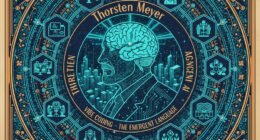The **combination** of artificial intelligence and digital transformation reveals the key to achieving operational excellence. Entering the realm of automation and cutting-edge technologies brings a mix of excitement and carefulness. Join this thrilling adventure to discover the hidden potential of AI and digital transformation for optimal success.
We understand the concerns of our workforce, who fear being left behind in this rapidly evolving landscape. However, through comprehensive training and unwavering support, we can empower our employees to adapt, thrive, and embrace the changes that lie ahead.
Furthermore, integrating AI and digital transformation into our existing systems and processes requires meticulous planning and seamless coordination. With a focus on data security and privacy, we can navigate the challenges and forge a path towards operational excellence that surpasses all expectations.
Key Takeaways
- Reduction of operating expenses and increase in revenues through optimization of resource allocation, waste minimization, and streamlined workflows
- Identification of new revenue opportunities, improved customer satisfaction, and driving innovation
- AI algorithms analyzing large volumes of data in real-time, uncovering patterns and making accurate predictions
- Leveraging cloud computing for storing and processing large datasets, facilitating collaboration and scalability
Benefits of AI in Operational Excellence
We have witnessed firsthand the transformational impact of AI in driving operational excellence. Through digital transformation, businesses have been able to leverage the power of artificial intelligence (AI) to achieve operational excellence. AI has revolutionized decision-making, operations, strategies, and management in the production process. By harnessing the capabilities of AI, businesses can extract meaningful insights from big data, automate production capabilities, and enhance overall business processes.

One of the key benefits of AI in achieving operational excellence is its ability to reduce operating expenses and increase revenues. AI-powered systems can optimize resource allocation, minimize waste, and streamline workflows, resulting in cost savings. Additionally, AI can help businesses identify new revenue opportunities, improve customer satisfaction, and drive innovation.
Furthermore, the development of data-based AI and advancements in deep learning have significantly contributed to operational excellence. AI algorithms can analyze large volumes of data in real-time, uncover patterns and trends, and make accurate predictions. This enables businesses to make informed decisions, optimize production processes, and proactively address potential issues.
Cloud computing plays a crucial role in integrating AI into operations and improving overall efficiency. It provides the necessary infrastructure for storing and processing large datasets, as well as facilitating collaboration and scalability. By leveraging cloud-based AI solutions, businesses can access advanced analytics tools, deploy AI models, and scale their operations seamlessly.
Key Considerations for Digital Transformation
When embarking on digital transformation, it’s crucial to prioritize effective change management to ensure successful implementation. Digital transformation involves significant shifts in technology, processes, and culture within an organization. To navigate this complex journey, organizations must consider key factors that can influence the outcome of their transformation efforts.

Here are three key considerations for digital transformation:
- Clear Communication and Training: Communicating the benefits of AI and digital transformation to employees is essential for gaining their buy-in and support. Providing comprehensive training programs can equip employees with the necessary skills to embrace new technologies and processes.
- Addressing Resistance to Change: Resistance to change is a common challenge during digital transformation. Organizations must proactively address resistance by fostering a culture of openness and transparency. Engaging employees in the decision-making process and addressing their concerns can help mitigate resistance and ensure a smoother transition.
- Integration and Compatibility: Implementing AI and digital transformation may require integrating new technologies with existing systems. It’s crucial to carefully plan and coordinate the integration process to avoid compatibility issues. Conducting thorough assessments of existing systems and infrastructure can help identify potential roadblocks and ensure seamless integration.
Integrating AI and Digital Transformation
When integrating AI and digital transformation, there are several synergies that can enhance operational efficiency.
AI can automate processes, improve decision-making, and extract valuable insights from big data.
Digital transformation can optimize business processes and improve overall efficiency.

Synergies Between AI and Digital Transformation
Through the integration of AI and digital transformation, businesses can unlock the synergies that exist between these two transformative technologies. These synergies enable organizations to achieve operational excellence by leveraging the unique capabilities of AI and digital transformation.
- Enhanced decision-making: By combining AI’s ability to analyze large volumes of data with the digital transformation of information systems, businesses can make more informed and data-driven decisions. This improves the accuracy and efficiency of decision-making processes, leading to better outcomes and operational excellence.
- Increased efficiency and productivity: AI-powered automation and robotics, when integrated with digital transformation initiatives, streamline business processes and improve productivity. By automating repetitive tasks and optimizing workflows, organizations can achieve higher levels of efficiency and productivity, contributing to operational excellence.
- Improved customer experience: AI and digital transformation enable businesses to personalize and tailor their products and services to meet the specific needs and preferences of customers. By leveraging AI algorithms and digital technologies, organizations can deliver personalized experiences at scale, enhancing customer satisfaction and loyalty.
Enhancing Operational Efficiency
To further maximize operational efficiency, we can integrate AI and digital transformation into our business processes. By leveraging AI and new technology, we can automate tasks, streamline workflows, and eliminate bottlenecks in our operations.
AI-powered systems can analyze large amounts of data in real-time, providing valuable insights and enabling data-driven decision making. This not only improves the accuracy and speed of our decision-making process but also enhances overall business performance.
Furthermore, integrating AI into our information systems such as ERP and supply chain management allows us to optimize resource allocation, reduce costs, and improve productivity.

Ultimately, by embracing AI and digital transformation, we can achieve higher levels of operational efficiency, stay competitive in the market, and drive sustainable growth for our organization.
Impact on Business Processes
Integrating AI and digital transformation revolutionizes our business processes, enhancing their effectiveness and efficiency. Here are three ways in which this integration impacts our business processes:
- Automation: AI technology automates repetitive and mundane tasks, freeing up employees to focus on more strategic and value-added activities. This improves productivity and reduces errors, leading to operational excellence.
- Data-driven decision-making: Digital transformation enables businesses to collect and analyze vast amounts of data in real-time. AI algorithms can then process this data to provide actionable insights, enabling smarter and more informed decision-making. This improves the efficiency and accuracy of our business processes.
- Improved customer experience: AI-powered chatbots and virtual assistants enhance customer interactions by providing personalized and instant support. This not only improves customer satisfaction but also streamlines our business processes by automating customer service tasks.
Strategies for Achieving Operational Excellence
Our strategy for achieving operational excellence revolves around leveraging AI and digital transformation to optimize our processes. To begin, we’ll focus on identifying areas within our operations that can benefit from automation and AI technologies. By analyzing our current processes, we can pinpoint inefficiencies and bottlenecks that can be addressed through digital transformation. We’ll then invest in AI solutions that can streamline these processes, improving efficiency and reducing costs.
In addition, we recognize the importance of aligning our digital transformation strategy with our overall business objectives. This means not only automating existing processes but also exploring new opportunities made possible by AI and digital technologies. By embracing innovation and constantly seeking ways to improve our operations, we can stay ahead of the competition and deliver superior value to our customers.

Furthermore, we understand that achieving operational excellence requires a cultural shift within our organization. We’ll foster a mindset of continuous improvement and encourage employees to embrace new technologies and ways of working. Clear communication and training programs will be implemented to address any resistance to change and ensure a smooth transition.
In conclusion, our strategy for achieving operational excellence involves leveraging AI and digital transformation to optimize processes, aligning our strategy with business objectives, and fostering a culture of innovation and continuous improvement. By executing this strategy, we can position ourselves for success in the digital age.
Moving forward, we’ll explore the challenges we may face in implementing these strategies and how to overcome them.
Overcoming Challenges in Implementation
When implementing automation and AI, we often encounter adoption barriers and solutions, such as resistance to change. To overcome this challenge, change management strategies should be implemented, including clear communication and training to help employees understand the benefits.

Additionally, maximizing ROI potential is crucial, requiring careful planning, coordination, and addressing integration and compatibility issues.
Adoption Barriers and Solutions
To overcome the challenges in implementing AI and digital transformation, organizations must address the adoption barriers and find effective solutions to ensure successful implementation. Here are three key areas that need to be focused on:
- Change management: Resistance to change can hinder the adoption of AI. By implementing effective change management strategies, organizations can minimize resistance and facilitate a smooth transition. This includes clear communication, stakeholder engagement, and providing training and support to employees.
- Cultural constraints: Cultural barriers within organizations can impede the adoption of AI. To overcome this, organizations should foster a culture of innovation and promote the benefits of AI to employees. Clear communication and training programs can help employees understand the value and potential of AI, encouraging their buy-in and participation.
- Skills and expertise: Lack of employee skills and expertise in AI can be a significant barrier. Organizations need to invest in developing well-defined strategies and training programs to upskill employees and support them during the transition. This includes providing access to resources, training workshops, and mentorship programs.
Change Management Strategies
In addressing the adoption barriers outlined in the previous subtopic, we can now delve into the effective change management strategies needed to overcome challenges in the implementation of AI and digital transformation.
Change management strategies play a crucial role in ensuring a smooth transition and successful integration of automation and AI into an organization. Clear communication and training are essential to help employees understand the benefits of these technologies and address any resistance to change.

Additionally, careful attention must be given to data security and privacy concerns to protect sensitive information and maintain trust. Integration and compatibility issues can be overcome through meticulous planning and coordination.
Continuously monitoring and improving processes and systems are key to optimizing performance and achieving operational excellence in the era of digital transformation.
Maximizing ROI Potential
With a focus on optimizing performance and achieving operational excellence, we can now explore the challenges that arise in maximizing ROI potential during the implementation of AI and digital transformation.
To overcome these challenges and ensure a successful implementation, organizations must consider the following:

- Change management: Resistance to change is common when introducing automation and AI. Clear communication and training can help employees understand the benefits and mitigate resistance.
- Data security and privacy: Protecting sensitive data is crucial during digital transformation. Organizations must address concerns related to data security and privacy to gain the trust of stakeholders.
- Integration and compatibility: Integration issues may arise when implementing automation and AI. Careful planning and coordination are necessary to ensure seamless integration with existing systems.
Case Studies: AI and Digital Transformation Success Stories
Our research has uncovered several remarkable case studies that demonstrate the transformative power of AI and digitalization in achieving operational excellence.
Company A streamlined their operations using Robotic Process Automation (RPA), resulting in improved efficiency, accuracy, and customer satisfaction. By automating repetitive tasks, they were able to free up their employees’ time for more value-added activities.
Company B implemented AI-powered chatbots to enhance their customer experience. These chatbots reduced response times and improved customer satisfaction by providing quick and accurate answers to customer inquiries.
Company C optimized their supply chain using machine learning techniques. By accurately forecasting demand and improving supply chain management, they were able to minimize inventory costs and ensure timely delivery of products.

CMPC, a global leader in sustainable products, leveraged digitalization to improve their competitiveness, scalability, and visibility across the value chain. By integrating digital technologies into their operations, they were able to produce renewable fibers and sell sustainable products globally, contributing to a greener world while providing better service to their clients.
These case studies highlight the immense potential of AI and digital transformation in achieving operational excellence across various industries.
Future Trends in AI and Digital Transformation
As technology continues to evolve, AI and digital transformation are poised to shape the future of operational excellence. The integration of these technologies into business processes and systems allows organizations to achieve new levels of efficiency and effectiveness.
Here are three future trends in AI and digital transformation that will have a significant impact on achieving operational excellence:

- Focus on more strategic use of AI: As organizations become more familiar with the benefits of AI, they’ll shift their focus from basic automation to leveraging AI for strategic purposes. This includes adopting advanced algorithms, machine learning, and natural language processing to drive operational capabilities and make informed decisions.
- Enhanced customer experience through digital technologies: The use of AI and digital transformation enables organizations to better understand customer needs and preferences, leading to improved customer engagement and satisfaction. By leveraging AI algorithms and data analytics, businesses can develop fast and personalized customer service, ultimately creating new revenue growth opportunities.
- Integration of AI in supply chain management: AI and digital transformation can streamline operations in the supply chain by reducing waste, increasing productivity, and improving the quality of products and services. Through real-time data analysis and the Internet of Things (IoT), organizations can optimize their supply chain processes and systems, resulting in cost reduction and enhanced efficiency.
These trends highlight the potential of AI and digital transformation to drive operational excellence and create a competitive advantage in the rapidly changing business environment. By embracing new technologies and continuously improving processes and systems, organizations can achieve their business objectives and thrive in the digital landscape.
Frequently Asked Questions
How Is AI Used in Operational Excellence?
AI is used in operational excellence by leveraging its capabilities to optimize business processes, improve decision-making, and enhance overall efficiency.
With AI, we can extract valuable insights from big data, automate production capabilities, and reduce operating expenses.
By integrating AI into operations, we can achieve better resource allocation, predictive maintenance, and real-time monitoring.

AI enables us to streamline operations, increase productivity, and ultimately drive towards operational excellence.
How Digitalization Can Enhance Operational Excellence?
Digitalization enhances operational excellence by enabling businesses to:
- Streamline processes
- Improve efficiency
- Deliver better customer experiences
By harnessing the power of AI and data analytics, companies can:
- Gain valuable insights
- Automate tasks
- Make more informed decisions
This leads to:

- Increased productivity
- Cost savings
- Improved overall performance
With digital transformation, organizations can:
- Optimize their supply chains
- Enhance forecasting accuracy
- Leverage smart technologies
This allows them to drive operational excellence and stay competitive in today’s fast-paced business landscape.
How Can AI Improve Operational Efficiency?
AI can significantly improve operational efficiency by:
- Automating repetitive tasks
- Analyzing large amounts of data to extract valuable insights
- Optimizing business processes
By leveraging AI technologies, we can:

- Streamline operations
- Reduce errors
- Increase productivity
AI-powered systems can also enhance decision-making by:
- Providing real-time information
- Offering predictive analytics
Additionally, AI can enable:
- Proactive maintenance
- Predictive scheduling
This can lead to:
- Improved resource utilization
- Cost savings
How to Achieve Operational Excellence Using Information Technology?
To achieve operational excellence using information technology, we must focus on improving our business processes and leveraging the power of data. By implementing efficient systems and technologies, we can streamline operations, automate tasks, and enhance decision-making.

It’s crucial to invest in AI and digital transformation, as they enable us to extract valuable insights from big data, improve production capabilities, and ultimately gain a competitive edge. Effective data management and integration of AI into operations are key factors in achieving operational excellence.
Conclusion
In conclusion, embracing automation and AI for operational excellence is essential for organizations to thrive in the digital age.
While there may be initial resistance and challenges, addressing employees’ concerns and providing training and support will help them adapt.
By carefully integrating these technologies into existing systems and processes, organizations can achieve smoother implementation and minimize disruptions.

Protecting data security and privacy is crucial throughout this process.
As the saying goes, ‘Embracing change is the key to unlocking success in the future.’









